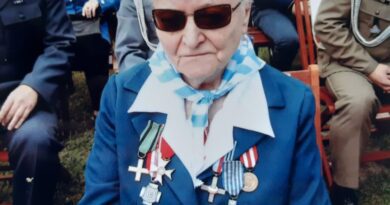Kamieniec Podolski: a city that has captured Polish imagination

Kamieniec was one of the “keys” to the borders of the Polish Commonwealth, of which there were three more in the 17th century – Gdańsk, Riga, and Smolensk.
Jacek Komuda
The prototype of the tragic hero of the Trilogy of Henryk Sienkiewicz died here – Michał Jerzy Wołodyjowski, a carpenter from Przemyśl who, together with Ketling, decided to blow up the fortress in Kamieniec after surrendering it to the Turks. But how did these events really unfold in historical reality, and not the fictional one? Who was to blame for the death of Jerzy Wołodyjowski on August 26th in the Old Castle? The answer is simple – the citizens of the Republic of Poland at that time.
In 1672, the Polish Crown and Lithuania were divided into two furiously fighting camps: noble-magnate, supporting king Michał Korybut Wiśniowiecki, and the malcontents party headed by primate Mikołaj Prażmowski and hetman Jan Sobieski. The malcontents tried to dethrone the ruler and install the French candidate, and even sought military intervention. The royal camp – just as the Polish opposition today – aimed at depriving opponents of their offices and dignity, and finally bringing them to justice. Nobody believed in the Turkish attack on Ukraine, and when Hetman Sobieski alarmed that an army was needed to defend the Crown, the royal court did everything to deprive him of ammunition and people, even going as far as attempting to foment a revolt in the Crown army to deprive him of power.
Kamieniec was almost in ruins. According to Piotr Derdej, the New Castle was outdated because it did not protect the city and the Old Castle from modern artillery. The Old Castle, built of stone, was easy to destroy. As the author writes: “The rest of the nobility in the Polish Commonwealth believed that Kamieniec was a fortress so powerful that it would always resist any storm, and therefore it does not need to be renovated or modernized”. What is worse, it was not agreed that the commander of the fortress should be the experienced general Marcin Kącki, but the post was entrusted to the governer of Kamieniec – Mikołaj Potocki, a good cavalry commander, who, nonetheless, did not know how to defend the fortresses. The crew was about 1,500 people, Wołodyjowski himself brought…24 dragoons and a dozen or so riders. Meanwhile, the huge army of the Sultan approached the city on August 16th. However, instead of storming, the enemies started firing at the city and castles from long-range artillery set on the hills around Kamieniec.
On August 20th, a part of the Old Castle was blown up, because the shell hit the powder magazine. At the same time, miners dug several trenches to blow up the fortifications of the New Castle. In this situation, it was decided to withdraw to the Old Castle on August 25th, which was built on rocks – Wołodyjowski thought that the Turks would not excavate underneath them. He was wrong, and his decision proved disastrous. The stone walls of the Old Castle collapsed into rubble under the fire of artillery. Although the defending army left mines in the New Castle, which exploded, inflicting losses on the Turks, they did not turn the entire fortress into rubble, and its terrain turned out to be perfect for shelling the Old Castle – this can be witnessed to this day. What’s more, the Turks did not give up digging the trenches in the slightest, channeling them in the rock under the Smoke Tower, and blew up a large section of the walls. Wołodyjowski and other officers decided to demolish the Old Castle in order to defend themselves from behind the embankment made of earth and debris. However, at that point Potocki and part of the command decided to surrender the city.

Wołodyjowski returned to the Old Castle to take his people. When he entered the courtyard, an explosion took place. Struck by the shards of debris, Wołodyjowski was killed. The explosion was unexpected – the Poles thought that the Turks blew up a mine, while the Turks that the opponent severed the negotiations! Historians and diarists have not been able to establish a final version. Stanisław Makowiecki claimed that the Old Castle was blown up by Major Hejking, an artilleryman serving in Kamieniec from the times of King Władysław. Others assume that the explosion was accidental. There is also a second version of Wołodyjowski’s death – in which he rode into the courtyard on horseback and was accidentally hit in the head with a round from a Polish cannon, because following the explosion, all of the loaded cannons fired. Based on Stanisław Makowiecki’s account, he along with the Turkish Grand Vizier, who entered the castle to check what had happened, found Wołodyjowski’s body. “Wołodyjowski’s carcass was on the ground”, he writes, “the entire back part of the head was blown away, there was not even a sign of the bones from the skull or the brain, one face remained entirely” […]. The body of the carpenter from Przemyśl was buried in the Franciscan church in Kamieniec, where it remains to this day.
If you want to locate the place of Michał Wojodyjowski’s death today, it is enough to enter the Old Castle through the gate from the city side and stop in the courtyard, with the ruins of the powder tower on your right. It was here that “Hector Kamieniecki”1 died.
This article was published in 2022 in “Do Rzeczy” magazine.
1 Wołodyjowski is sometimes called “Hector Kamieniecki”, as an allusion to Hector of Troy, a symbol of bravery and honor.



